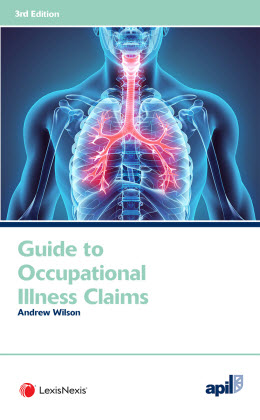
APIL Guide to Occupational Illness Claims
This content is unique to LexisNexis
Commentary
CURRENCY: 3rd Edition, August 2019
The APIL Guide to Occupational Illness Claims is a practical handbook designed for all those involved in this area of specialist personal injury litigation.
Applying the law of compensation to help those individuals is a complex process. Long latency periods, knowledge of the law at the time of exposure, understanding of the causative issues and legal tests all require specialised skill and understanding to represent injured people.
This book provides practical guidance through the minefield of occupational disease claims. Covering general principles, the different types of conditions, the statutory framework as well as practical issues and quantum assessment. It takes time to discuss the thorny causation tests that can apply when science can only get you so far in identifying risks caused by breach, as well as covering practical issues such as restoration of companies to the register or using third-party rights against the insurer act.
It is a one-stop source of reference, which provides:
* an outline of the myriad statutory provisions which regulate this area and the effective date of those provisions, helping you to identify which provision was in force at the date of exposure
* the nature and medical background to common occupational illnesses
* an explanation of the problems associated with complicated expert evidence
* practical advice on pursuing and valuing the claim, the procedure for restoring companies to the register, etc.
* expertly drafted precedents, draft schedules of damages and model pleadings
The APIL Guide to Occupational Illness Claims is a practical handbook designed for all those involved in this area of specialist personal injury litigation.
Applying the law of compensation to help those individuals is a complex process. Long latency periods, knowledge of the law at the time of exposure, understanding of the causative issues and legal tests all require specialised skill and understanding to represent injured people.
This book provides practical guidance through the minefield of occupational disease claims. Covering general principles, the different types of conditions, the statutory framework as well as practical issues and quantum assessment. It takes time to discuss the thorny causation tests that can apply when science can only get you so far in identifying risks caused by breach, as well as covering practical issues such as restoration of companies to the register or using third-party rights against the insurer act.
It is a one-stop source of reference, which provides:
* an outline of the myriad statutory provisions which regulate this area and the effective date of those provisions, helping you to identify which provision was in force at the date of exposure
* the nature and medical background to common occupational illnesses
* an explanation of the problems associated with complicated expert evidence
* practical advice on pursuing and valuing the claim, the procedure for restoring companies to the register, etc.
* expertly drafted precedents, draft schedules of damages and model pleadings

